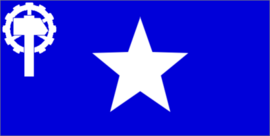Flag of The North American Socialist Commonwealth
| Name | The Sapphire Star |
| Use | Civil and state flag |
| Proportion | 1:2 |
| Adopted | Adopted as a revolutionary icon, 13. October. 2030.
Adopted as an official national flag, 15. April. 3031 |
| Design | A white hammer and gear on the canton, and a single large white star in the center of a flag with a royal blue background. |
The national flag of The North American Socialist Commonwealth. It is comprised of a white Hammer & Gear in the canton, and a large white Star over a deep blue background. It is called the Sapphire Star.
History
The first time the Sapphire Star was known to be displayed was during the revolution. It was also the same time that the Commissar became enshrined as a revolutionary hero. It was during this event that the Commissar walked into a clash between more militant revolutionaries and police forces. In the clash, The Commissar served as a great inspiration in the midst of the battle, waving around a flag he carried, a blue banner with a white star. Though the man was shot down during the combat, others took up the banner, and managed to beat back government authorities, even military authorities. This clash was later found to be instrumental in the eventual collapse of the government. Shortly after the event, The Commissar, and more importantly the Sapphire Star became symbols of the revolution, the combination of which TYS used to maximum effect. The flag was adopted by the Provisional Government and has been the Commonwealth's flag ever since.
Symbolism
The symbolic power of the Sapphire Star is relatively simple. The white star is meant to represent the nation, an ever burning light, no matter how dark the night gets, and a ray of hope. The Hammer and Gear represent the productive power of the Commonwealth, and the industriousness of its people. The color combination, royal blue and white is meant as an alternative to the red and gold of typically socialist flags, for a new and democratic socialist state.
Display and Etiquette
The Sapphire Star is displayed on almost all government buildings, and is a frequently flown by citizens. Display of the Sapphire Star is generally restricted to daylight hours, except if one can keep a light source on the flags. Flags are supposed to be kept relatively clean, intact, and otherwise in good form. Additionally, flags are not supposed to touch the ground, especially in the case of military flags. In the event a flag must be retired, it is to be put to the torch after a brief ceremony.
Variations
Civil and Government
| Flag | Date | Use | Description |
|---|---|---|---|
 |
2030-Current | Civil and Government Flag | The default flag, used by civilians and government officials alike. |
| 2035-Current | Government Flag | A vertical version of the default flag. This flag is seen hanging on government buildings. |
Military
| Flag | Date | Use | Description |
|---|---|---|---|
| File:NASCMartialFlag.png | 2035-Current | Military Flag | Used by CODFOR and (to a lesser extent) CIDFOR from 2035 until shortly after the opening. Still used by CIDFOR. Also considered a naval ensign. |
| File:NASCNewMartialFlag.png | 2050-Current | Military Flag | Used by CODFOR from 2050 until the current day. Also used as a naval ensign. |
| File:NASCNavyJack.png | 2035-Current | Naval Jack | Used by the Commonwealth Navy as a Naval Jack, unless an Admiral is present on ship. |
| File:NASCAdmiral'sJack.png | 2035-Current | Admiral's Jack | Used in the Commonwealth Navy as an Admiral's replacement Jack for the flagship of a fleet. |
Historical
| Flag | Date | Use | Description |
|---|---|---|---|
| File:USAFlag.png | 1777-2030 (Still sees ceremonial use) | Ceremonial Flag | Flag of the Pre-Revolutionary United States. Still sees use during memorial services and on the graves of USAF veterans. |
| File:TYS1stFlag.png | 2028-February. 2030 | Revolutionary Flag | The first flag used by an The Young Socialists. Did not see widespread use outside this circle. |
| File:TYS2ndFlag.png | February. 2030-October. 2030 | Revolutionary Flag | The second flag used by The Young Socialists. Saw limited use along the East Coast. |
